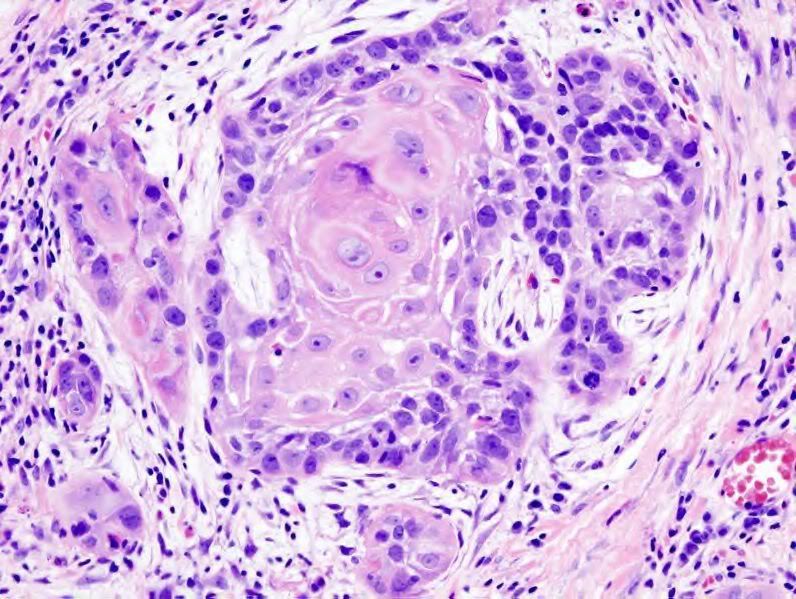In 2007, in the US alone, about 34,000 individuals will be diagnosed with oral cancer. 66% of the time these will be found as late stage three and four disease. Low public awareness of the disease is a significant factor, but these cancers could be found at early highly survivable stages through a simple, painless, 5 minute examination by a trained medical or dental professional.
All cancers are diseases of the DNA in the cancer cells. Oncogenes are activated as a result of mutation of the DNA. The exact cause is often unknown. Risk factors that predispose a person to oral cancer have been identified in epidemiological studies.
Smoking and other tobacco use are associated with about 75 percent of oral cancer cases, caused by irritation of the mucous membranes of the mouth from smoke and heat of cigarettes, cigars, and pipes. Tobacco contains over 19 known carcinogens, and the combustion of it, and by products from this process, is the primary mode of involvement. Use of chewing tobacco or snuff causes irritation from direct contact with the mucous membranes.
In many Asian cultures chewing betel, paan and Areca is known to be a strong risk factor for developing oral cancer. In India where such practices are common, oral cancer represents up to 40% of all cancers, compared to just 4% in the UK.
Alcohol use is another high-risk activity associated with oral cancer. There is known to be a strong synergistic effect on oral cancer risk when a person is both a heavy smoker and a drinker. Their risk is greatly increased compared to a heavy smoker, or a heavy drinker alone.
Some oral cancers begin as leukoplakia a white patch (lesion), red patches, (erythroplakia) or non healing sores that have existed for more than 14 days. In the US oral cancer accounts for about 8 percent of all malignant growths. Men are affected twice as often as women, particularly men older than 40/60.
Human Papilloma Virus, (HPV) particularly versions 16 and 18 ( there are over 100 varieties) is a known risk factor and independent causative factor for oral cancer. (Gilsion et.al.Johns Hopkins) A fast growing segment of those diagnosed does not present with the historic stereotypical demographics. Historically that has been people over 50, blacks over whites 2 to 1, males over females 3 to 1, and 75% of the time people who have used tobacco products or are heavy users of alcohol. This new and rapidly growing sub population between 20 and 50 years old is predominantly non smoking, white, and females slightly outnumber males. Recent research from Johns Hopkins indicates that HPV is the primary risk factor in this new population of oral cancer victims. HPV16/18 is the same virus responsible for the vast majority of all cervical cancers and is the most common sexually transmitted infection in the US. Oral cancer in this group tends to favor the tonsil and tonsillar pillars, base of the tongue, and the oropharnyx. Recent data suggest that individuals that come to the disease from this particular etiology have some slight survival advantage
Symptoms
Skin lesion, lump, or ulcer:
On the tongue, lip, or other mouth area
Usually small
Most often pale colored, may be dark or discolored
Early sign may be a white patch (leukoplakia) or a red patch (erythroplakia) on the soft tissues of the mouth
Usually painless initially
May develop a burning sensation or pain when the tumor is advanced
Additional symptoms that may be associated with this disease:
Tongue problems
Swallowing difficulty
Mouth sores that do not resolve in 14 days
Pain and paraesthesia are late symptoms.
Treatment
Surgical excision (removal) of the tumor is usually recommended if the tumor is small enough, and if surgery is likely to result in a functionally satisfactory result. Radiation therapy is often used in conjunction with surgery, or as the definitive radical treatment, especially if the tumour is inoperable. Chemotherapy is commonly used for more advanced tumours, often in combination with radiotherapy and surgery. Biological agents, such as Cetuximab have recently been shown to be effective in the treatment of squamous cell head and neck cancers, and are likely to have an increasing role in the future management of this condition.
Owing to the vital nature of the structures in the head and neck area, surgery for larger cancers is technically demanding. Reconstructive surgery may be required to give an acceptable cosmetic and functional result. Bone grafts and surgical flaps such as the radial forearm flap are used to help rebuild the structures removed during excision of the cancer.
Survival rates for oral cancer depend on the precise site, and the stage of the cancer at diagnosis. Overall, survival is around 50% at five years when all stages of initial diagnosis are considered. Survival rates for stage 1 cancers are 90%, hence the emphasis on early detection to increase survival outcome for patients.
Following treatment, rehabilitation may be necessary to improve movement, chewing, swallowing, and speech. Speech therapists may be involved at this stage.

- last post
- 14 years ago
- posts
- 9
- views
- 4,256
- can view
- everyone
- can comment
- everyone
- atom/rss
Copyright © 2024 Social Concepts, Inc. All Rights Reserved. Patent Pending.
blog.php' rendered in 0.0796 seconds on machine '109'.


